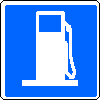 To
Next Fuel (E85)
To
Next Fuel (E85)Home - Background: Fuel Types - M85
Methanol is typically made from natural gas; though it is possible to produce it by fermenting biomass (this is why it is sometimes called "wood alcohol"), this is not economically competitive yet. Because it is easier to transport natural gas to a distant market by converting it to methanol, which is a liquid at ordinary temperatures and pressures, than by chilling and liquefying it or by building a long pipeline, some petroleum-exporting countries are looking at exporting their "waste" natural gas (which they currently "flare off" in huge flames visible from the Space Shuttle!) by converting it to methanol; however, most of the natural gas that goes into methanol in the United States is still domestically produced. For reasons to be explained below, most fuel methanol in this country is sold as a blend of 85% methanol with 15% unleaded premium gasoline, whence "M85". In the not-too-distant future, "neat" (100%) methanol may be the preferred means of storing hydrogen for fuel-cell electric vehicles, but this technology is still in the R&D stage.
There have been efforts to introduce M85 into various fuel markets, notably in California, but there is no nationwide transportation network in place for this as a bulk fuel (on the scale of gasoline, diesel fuel, or natural gas) yet. The methanol industry's efforts to enter the transportation fuels market recently have been largely focused on a derivative compound called methyl tert-butyl ether (MTBE), an additive used in oxygenated gasoline, though concerns about water table contamination have caused this to lose favor.
There are still not very many M85 stations in the United States. However, only relatively small changes need to be made to a gasoline fueling station (linings and seals in tanks, pumps, dispensers, ...) in order to handle M85, compared to the completely new construction needed to handle compressed or liquefied natural gas (CNG or LNG) or liquefied petroleum gas (LPG), so M85 capability can be added in a big hurry if local governments, consumers (usually fleets), and retailers decide to develop a market.
Alcohol fuels like M85 are perhaps the most "transparent" alternative fuels to the user, i.e., they are the least distinguishable from gasoline in how you buy and use them, which should ease acceptance. The fuel system of a car or truck only needs to be slightly changed (somewhat different materials, bigger fuel injectors, and a fuel composition sensor) in order for it to run on M85, and recently automakers have been offering M85 vehicles at no extra cost over their gasoline counterparts (or even for slightly less money), though at present automakers seem to be more interested in ethanol (E85). At least in California, the fuel costs about the same per mile as mid-grade gasoline (that is, you need about 1.7 gallons of M85 to get the same driving range as one gallon of gasoline, but price of a gallon of gasoline is about 1.7 times the price of a gallon of M85, so it balances out). And perhaps best of all, modern M85 vehicles are flex-fuel vehicles, which means that any mixture of M85 and gasoline in the fuel tank can be used by the engine; a fuel-composition sensor tells the engine computer what percentage of methanol is in the fuel, and it adjusts the injectors and ignition accordingly. Thus an M85 vehicle is a gasoline vehicle if M85 is not available, but you can top it off with M85 whenever you get back into an area where it can be found, and you don't have to carry (and pay for!) two separate fuel systems to do this.
Methanol is more corrosive than gasoline (though it is less toxic, and not carcinogenic); this is why an automaker needs to change some of the materials in the fuel-handling systems of both the vehicle and the refueling station to materials that can withstand attack by the fuel. Special oil additives are necessary in order to protect the engine. Also, because the mixture of air to fuel is much richer than gasoline (about 8 to 1 by weight, compared to about 14 to 1 for gasoline), there is more liquid fuel available to wash oil off of cylinder walls during a cold start. Some early methanol users experienced durability problems, but development work has been making steady progress.
The richer fuel/air mixture needed by methanol also means that a given volume of gasoline will take you about 70% farther than the same tank full of M85; most automakers have at least partially compensated for this by putting a larger fuel tank in their M85 vehicles. And the reason that methanol is most commonly used in a mixture with 15% gasoline is to correct for two disadvantages of pure methanol. One is that a methanol flame is colorless, so gasoline is added to give the flame some color so rescuers can tell if a fire is present should an M85 vehicle get into a crash. The other is that methanol, being a pure chemical compound, has a single boiling point, so that it can cause cold-start problems in cold weather, or vapor lock in hot. Gasoline, being a mixture of compounds with different boiling points, always has some components that want to stay liquid and some that want to vaporize at a given temperature, so adding it to methanol confers this flexibility on the M85 mixture. Indeed, some manufacturers recommend mixing additional gasoline with M85 in very cold weather.
 To
Next Fuel (E85)
To
Next Fuel (E85) Back
to Fuel Types
Back
to Fuel Types Back
to Fueling Station
Back
to Fueling Station Site
Map
Site
Map Contact
Me
Contact
Me All content copyright 1998-2024 by Mark Looper, except as noted. Reuse of my copyrighted material is authorized under Creative Commons Attribution 4.0 International license (CC BY 4.0).
![]()
![]()
new 11 July 1998, revised 10 December 2000